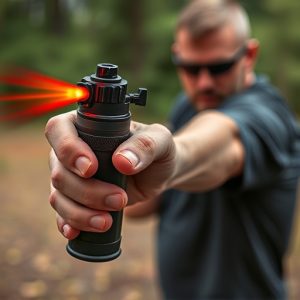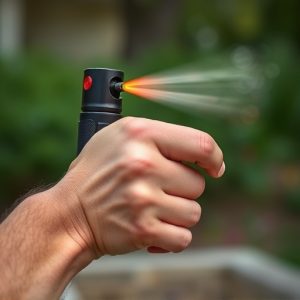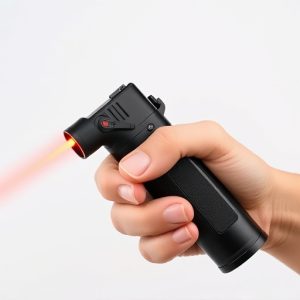Pepper Spray Safety: Handling, Storage, and Decontamination Guide
Pepper spray, a powerful self-defense tool, relies on capsaicin from chili peppers to temporarily di…….
Pepper spray, a powerful self-defense tool, relies on capsaicin from chili peppers to temporarily disable attackers. After exposure, immediate decontamination is crucial. This involves removing contaminated clothing, rinsing affected areas with warm water for 15 minutes, and gently cleansing with mild soap, focusing on creases and sensitive parts. Unauthorized use carries severe legal consequences; understanding and adhering to local laws regarding possession, deployment, and aftermath is essential. Proper storage and handling are also critical to maintain the spray's effectiveness and safety.
“Uncover the power and potential pitfalls of pepper spray as a self-defense weapon. This comprehensive guide explores the science behind this non-lethal deterrent, offering insights into its composition and effectiveness. We delve into best practices for safe handling and storage, emphasizing responsible ownership. Additionally, learn crucial steps to decontaminate skin after exposure to pepper spray, ensuring safety and peace of mind. Understanding legal considerations is also vital; we clarify responsibilities to empower users in the event of self-defense.”
- Understanding Pepper Spray: Its Composition and Effects
- Safe Handling and Storage of Pepper Spray
- Decontaminating Skin After Exposure: A Step-by-Step Guide
- Legal Considerations and Responsibilities for Self-Defense Weapons
Understanding Pepper Spray: Its Composition and Effects
Pepper spray, a powerful self-defense tool, is designed to incapacitate an attacker temporarily. Its primary active ingredient is capsaicin, a natural compound derived from chili peppers. This substance irritates the eyes, nose, and respiratory system when it comes into contact, leading to temporary blindness, coughing, and difficulty breathing. Understanding this composition is crucial for users to know how to handle and decontaminate their skin after use.
When pepper spray makes contact with the skin, it can cause severe irritation and even chemical burns. Users should act swiftly by removing any contaminated clothing and thoroughly rinsing the affected areas with warm water. The decontamination process is vital to ensure no residual capsaicin remains on the skin, which could potentially lead to prolonged discomfort or even more severe reactions.
Safe Handling and Storage of Pepper Spray
Proper handling and storage of pepper spray are essential for ensuring its effectiveness and safety. Always treat pepper spray as a hazardous material, keeping it out of reach of children and unauthorized individuals. After each use, decontaminate your skin and clothing by rinsing thoroughly with water to prevent irritation or any potential long-term effects. Store the spray in a cool, dry place away from direct sunlight and heat sources. It’s recommended to keep it in its original packaging, which often includes a child-resistant mechanism for added security. Regularly check the expiration date, as pepper spray can lose its potency over time.
When not in use, ensure the nozzle is directed away from your body and any surfaces that could be accidentally sprayed. Avoid leaving it in vehicles or places prone to extreme temperature fluctuations, as this can compromise its integrity. If you notice any signs of damage or leakage, dispose of the spray promptly and get a replacement. Remember, proper care and handling will not only maintain the functionality but also ensure your safety when facing potential threats.
Decontaminating Skin After Exposure: A Step-by-Step Guide
After exposure to pepper spray, decontaminating your skin is a crucial step for safety and discomfort relief. Start by removing any clothing or accessories contaminated with the spray, taking care not to rub the affected area, as it can spread the irritants further. Rinse the exposed skin liberally with clean, running water for at least 15 minutes. This helps to dilute and wash away the pepper spray chemicals.
Next, use a mild soap to gently cleanse the skin, focusing on the affected areas. Ensure that you thoroughly clean under nails, around eyes, and in any creases or folds of skin where pepper spray might have accumulated. Pat the area dry gently using a soft, clean towel. If irritation persists or becomes severe, consult medical advice immediately.
Legal Considerations and Responsibilities for Self-Defense Weapons
Using pepper spray as a self-defense weapon comes with legal considerations and responsibilities that should never be overlooked. Before carrying or using any type of self-defense tool, including pepper spray, familiarize yourself with local laws and regulations. Each jurisdiction has its own rules regarding who can possess and use these devices, and the circumstances under which they can be legally employed. Unauthorized use could result in severe penalties, including fines and imprisonment.
It’s crucial to understand that while pepper spray is designed for self-defense, it should only be deployed when absolutely necessary to protect yourself from imminent harm. After using pepper spray, it’s essential to take steps to decontaminate your skin to minimize potential legal issues or false accusations. This involves thoroughly washing the affected areas with soap and water and seeking medical attention if necessary. Properly documenting the incident, including reporting it to local authorities, is also vital to protect yourself should any legal consequences arise.
In conclusion, pepper spray can be a valuable tool for self-defense, but its safe handling, storage, and proper decontamination of skin after exposure are paramount. By understanding the composition and effects of pepper spray, following safe practices, and knowing legal considerations, individuals can protect themselves effectively while minimizing risks. Always remember to decontaminate skin from pepper spray promptly to prevent irritation and ensure your safety in any self-defense scenario.


